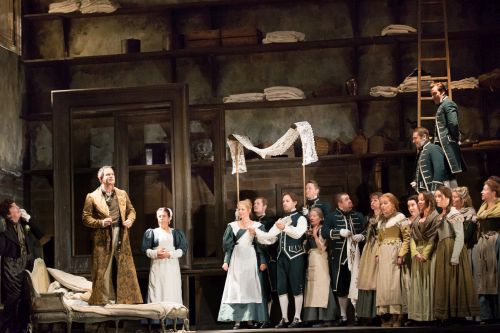 United Kingdom Mozart Le nozze di Figaro Soloists, Chorus & Orchestra of the Royal Opera House, Covent Garden/David Syrus. Royal Opera House, Covent Garden, 02.05.2014 (CC)
United Kingdom Mozart Le nozze di Figaro Soloists, Chorus & Orchestra of the Royal Opera House, Covent Garden/David Syrus. Royal Opera House, Covent Garden, 02.05.2014 (CC)

Le Nozze Di Figaro
Photo Credit: ROH/Mark Douet
Figaro: Alex Esposito
Susanna: Camilla Tilling
Bartolo: Christophorus Stamboglis
Marcellina: Marie McLaughlin
Cherubino: Anna Bonitatibus
Countess Almaviva: Rebecca Evans
Count Almaviva: Gerald Finley
Antonio: Jeremy White
Don Curzio: Timothy Robinson
Barbarina: Dušica Bijeliċ
At the end of August last year, Glyndebourne brought their Figaro to the Proms in a semi-staged production that brought much joy (see review). Here over at Covent Garden is the sixth revival of David McVicar’s production first seen in 2006, which moves the action to 1830, a time on the cusp of revolution. Hierarchies between nobility and servants were particularly tense at this time. House staff are seen on-stage during the overture, bustling around and scrubbing floors. When the opera finishes, a single maid is seen scrubbing the floor again – despite the intrigues of the preceding hours, the underlying hierarchy remains intact, at least for now.
Scene changes throughout are slick and impeccably managed. The sets, by Tanya McCallin, are both of a realistic bent yet can carry magic, too, especially with the expert lighting of Paule Constable, itself particularly impressive in the nocturnal scenes.
Over and above all this was the intelligent casting. Whatever the occasional individual failings, there was the definite feel of an ensemble at work here. It was no surprise learn that Alex Esposito was playing Figaro for the first time here; he took time to find his legs: the emotions of his “Se vuol ballare” not quite believable and presented with an over-dramatic element that even threatened to derail the odd phrase. Yet the correction was swift and his characterisation swiftly became more credible: by “Non più andrai” there was a marked improvement in this regard. Throughout the rest of the evening his voice was admirably focused, his diction exemplary.
Swedish soprano Camilla Tilling took the part of Susanna, her first time in this role at Covent Garden (she sang it most recently at the Paris Opéra in 2012). Her initial exchanges with her Figaro were very well managed, her later, second act aria “Venite, inginocchiatevi” was beautifully light and cheeky, while in the final act she raised herself to the very top of her game.
Mezzo Anna Bonitatibus was an excellent Cherubino (who took the role previously here in both 2008 and 2012), perfectly embodying this character’s youthful naivete. But above all of these singers was baritone Gerald Finley’s exemplary Count. Finley was the Count in the original 2006 production, and his experience showed. His regal way with “Hai gia vinta la causa” spoke reams about his entire interpretation: perfectly in control vocally, impeccably masculine with hints of suppressed violence.
The Countess, the Welsh soprano Rebecca Evans, was another singer making a role debut (she has previously sung this role with WNO). Her sense of line in the second “Porgi amor” gave the aria a delicious sense of inevitability, a trait echoed to perfection in “Dove sono” from the next act. How wonderful, too, to see Maria McLaughlin on stage as Marcellina. McLaughlin made her Royal Opera debut back in 1980 (she was Marcellina also in 2010). Her dramatic presence was astonishing, her voice in fine fettle.
The remaining parts were cast from strength. Christophoros Stamboglis as Bartolo was especially fine in the big-boned core of “La vendetta”; Serbian soprano and Jette Parker artist Dušica Bijeliċ was a splendid Barbarina both in and around her final act aria, “L’ho perduta”. It is nice to see a name to watch out for; we will be seeing more of Bijeliċ if there is any justice.
David Syrus conducted well. The performance was not quite world class, though, as if the Covent Garden orchestra was seeking the last ounce of inspiration. Orchestral ensemble was generally fine, which made the odd stumble or two later on in the evening all the more obvious to the listener. But the fact is that the whole transcended the sum of the parts.
Colin Clarke
Too generous. Never mind the second half, there were enough vocal fluffs and strain from Susanna and (particularly) the Countess in the first half to warrant concern, never mind the lack of cohesion in the orchestra and between stage and pit. Sad slow samey evening with too many mistakes. Buyer beware.